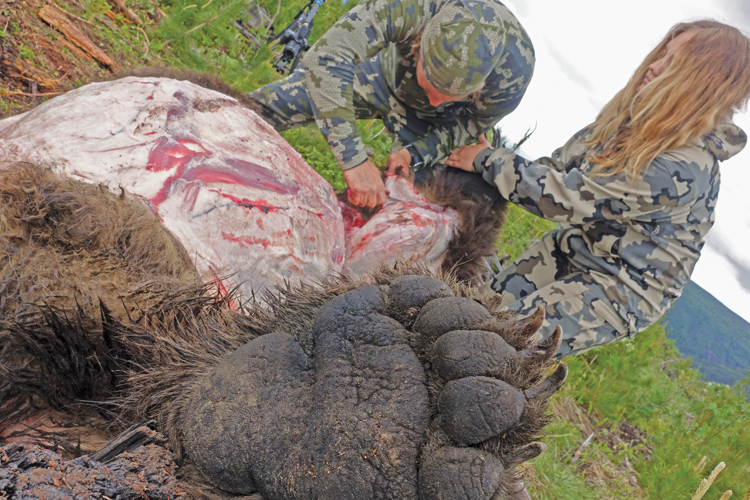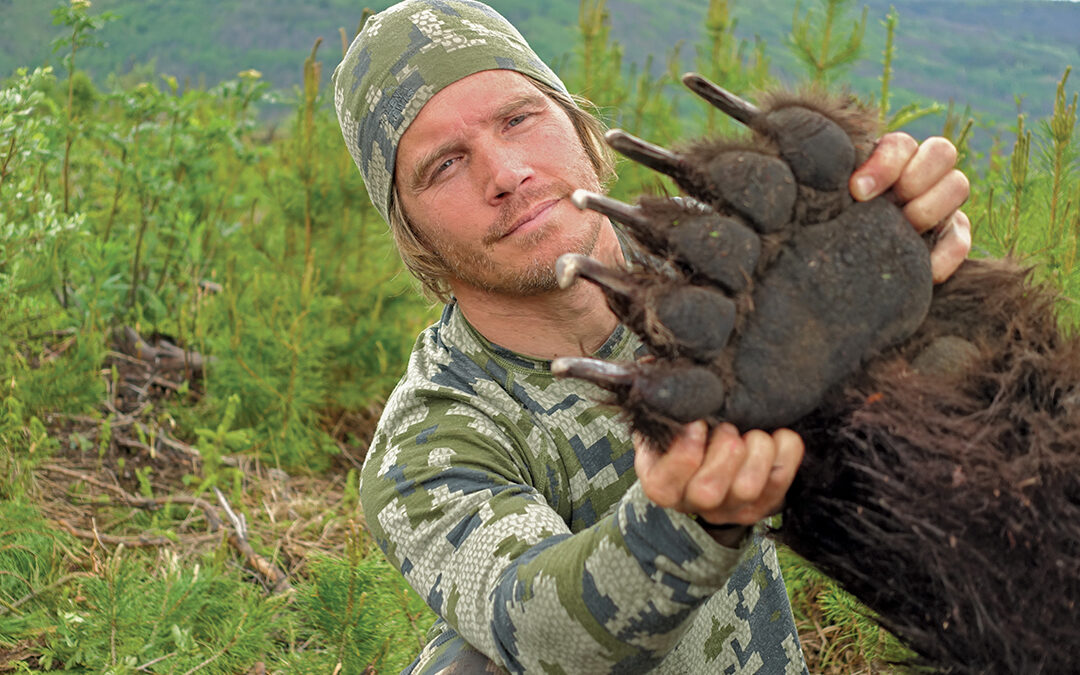When I prepare for a hunt, I spend time visualizing how it will happen. So, for months leading up to last spring, I pictured a big grizzly calmly feeding at 35 yards and a well-placed arrow striking him from an unidentifiable source. Just how a bear hunt should play out. Just the way I wanted it to.
However, in June 2017, as a giant boar charged full-speed toward me, I realized that reality often differs from fantasy, and that my pre-hunt visualization exercises did not prepare me for the dangers I now faced. With no broadside shot or a life-saving rifle blast just heartbeats away, I was forced to make one of the hardest decisions— and shots—of my life.
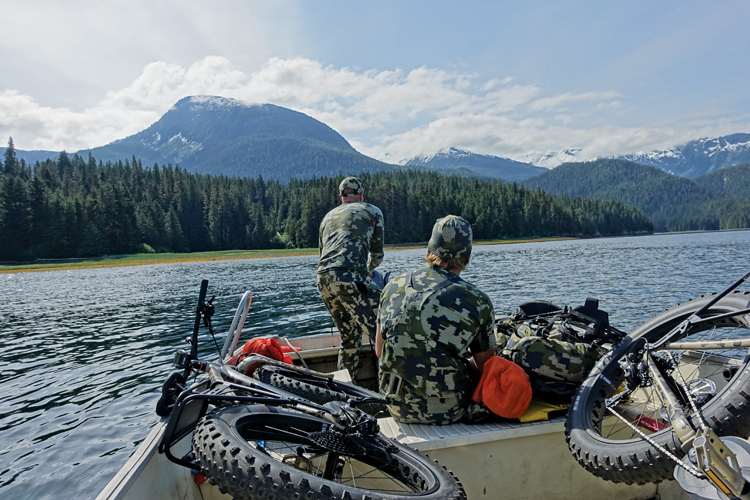
Spike Lewis, Dave Bolen and I own Bolen Lewis Guiding Co., a British Columbia outfitter that for more than a decade has built a reputation for hunting some of North America’s biggest black bears, mountain goats and grizzlies.
When I expressed a desire to bow-hunt for a Boone and Crockett grizzly, Spike jumped at the chance to guide me. I was stoked when I saw his willingness and excitement. After all, if the best guide I knew believed in my long-shot dream, then why shouldn’t I?
We set out in late May and soon found that hot weather had pushed the bears to higher-than-normal elevations. As the first half of the hunt rolled by, the pressure grew. We were not seeing enough bears to believe we had a realistic chance of finding a B&C trophy. Yet for me, this hunt was a rare opportunity, so I decided to just enjoy the experience and not worry about success or failure. I’ve learned that keeping a positive attitude seems to attract good luck.
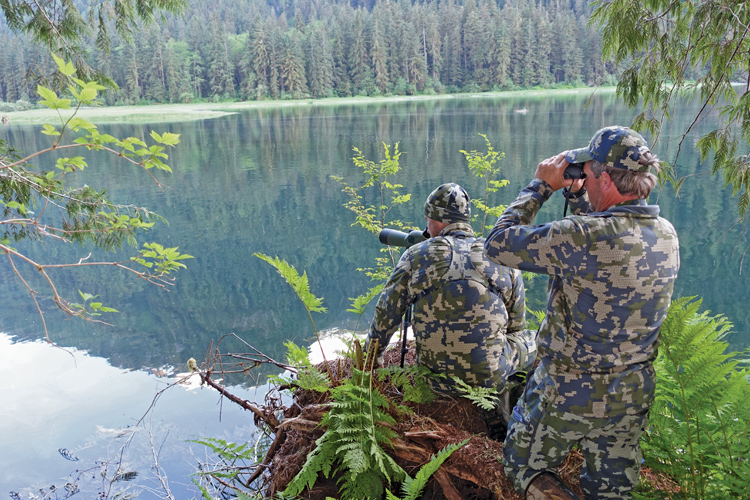
Well, as luck would have it, on our eighth day of the hunt, Ben and Brad, a couple of our guides who had been working a different area, spotted a mature grizzly they described as a “very big bear.”
I always find strategic decisions, like switching areas, to be the most gut-wrenching part of hunting. It feels like a gamble. Even choosing between two whitetail stands gives me anxiety, so the weight of this decision felt especially heavy. But a big part of hunting is using your instincts and best judgment. We debated a full day before decided to take a gamble and relocate for the remainder of our hunt.
Scouting a new spot evokes many emotions, like the thrill of the unknown and the hope of a finding a giant. But it also brings worry and fear, and the eventual realization that reality can trump hope. More times than not, the myth of a giant remains a myth, and most great hunches usually end up as nothing more than just that—hunches. But this time we got lucky.
On our first day in the new area, we saw a mind-blowing number of rutting boars. Apparently, the scent of a hot sow had drawn them into this particular valley. Since we never saw her, we assumed that like a herd bull, the alpha boar was keeping her to himself, and it was just a matter of time before he showed himself. Waves of anticipation delayed my sleep that night.
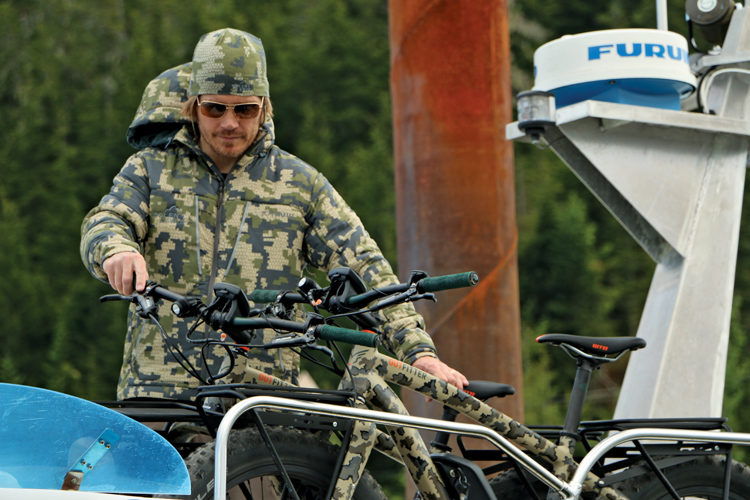
Late the next morning, Spike spotted a male grizzly following a sow moving toward a gravel road. The boar was massive, with an awe-inspiring head and shoulders. He made the mature sow look like a cub. This was the alpha male—the King of the Mountain.
The wind was good, so we jumped on our Felt Outfitter mountain bikes. These battery-assisted ebikes have become a lethal tool in our operation. Spike, our buddy Brian Walters and I zipped silently down the road, while my daughter, Kate, stayed posted at the spotting scope. Before rounding the final corner in the road, we stopped to recheck the wind. To our frustration, it had shifted, so we reluctantly backed away.
Later that afternoon, the bears showed themselves again on an old logging trail farther up the mountain. We figured that we could slip past them on the main road to gain the wind and then hike back through the bush to intercept their trail. But to complicate matters, we could also see two big satellite boars a couple hundred yards on either side of the King and his sow.
On our bikes, Spike and I easily got past the bears. When we started climbing through the bush, we could hear grizzlies roaring on the hill above us. Neither of us had ever heard anything like it. The aggressiveness of these bears made my hair stand on end.
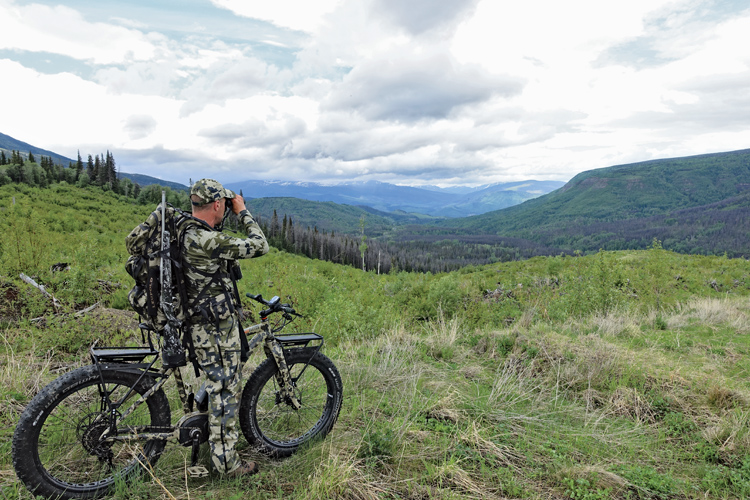
Just after we hit the logging trail, we were nearly run over by one of the satellite boars. He could both see and smell us, so we tried to cut a wide circle around him, but three different times he walked right at us, once to within 20 yards. We couldn’t shout at him for fear of alerting the big boar, so we just stood our ground, nervously waving our arms.
When we finally reached the spot where we had seen the boar and sow, we found the trail empty. As we stood there whispering in our stocking feet, the sow suddenly sprang over the bank onto the trail 70 yards ahead. She immediately saw us standing there in the wide open. Seconds later, she looked back down the trail as the King of the Mountain strode up behind her. He was magnificent.
We used the distraction to our advantage and quickly crawled behind some alders, remaining undetected by the boar. But the sow was nervous about us and made several attempts to leave him. Finally, despite his efforts, she escaped him and circled to catch our wind.
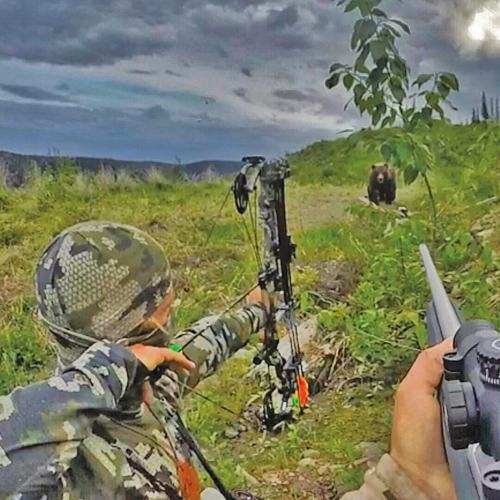
The huge grizzly was visibly irate that she’d left his side. When she approached us from the hill to our right, he’d finally had enough and charged down the trail to intervene. Perhaps he thought we were one of the satellite boars.
With the sow 25 yards to our side, the boar charged straight down the trail towards us. As he crossed the 30-yard mark, he slowed to a walk, and I came to full draw. On my knees, I still remember feeling so small compared to this giant animal that seemed to look down on us from level ground.
When he hit 20 yards, Spike hissed several times, hoping he would stop and turn broadside as the other bear had done just minutes earlier. But instead of stopping, he came straight at us, and I felt tremendous anxiety about finding the best shot placement. I dreaded a frontal shot on a 900-pound grizzly, but my options were quickly evaporating.
When he hit about 15 yards, I heard Spike say, “Okay!”
His tone was clear; the urgency in his voice screaming, “Okay already, shoot now! Before I have to.”
We were past the point of return. The bear knew we were there and he wasn’t stopping. It was either an arrow or a bullet.
His giant muzzle pointed downward, blocking a clear shot to his vitals through the front of his chest. I aimed just below his muzzle, but it still felt too low. At nine yards, I released the arrow. A huge roar accompanied the broadhead’s impact and the bear reared to his back legs before lunging forward, barreling down the path toward us. I jumped behind Spike and his rifle, dreading what I thought would be an impending shot. The boar charged full-tilt, yet time seemed to slow as I saw him look directly at us, and in a fight-or-flight moment of decision, he ran past us on the narrow logging trail, his massive body a mere six feet away. As he passed, I saw blood pumping in a torrent from his chest. The rifle had never sounded.

What had just happened? It took several moments to sink in, and though we were elated, we were also terrified. The first thing I remember saying was, “What are we doing, Spike? We have families! That was not good.”
To this day I am blown away that Spike Lewis did not put a bullet in that bear. The archery aspect of this trophy was intensely important to both of us, but Spike put it on the line that day as he made one of the most cool-headed decisions I’ve ever seen.
This bear is the trophy of a lifetime for Spike and me. We recognize the tremendous amount of luck that went into finding and bow-harvesting this animal. We are honored to have been a part of this, and forever grateful to have come through it safely.
